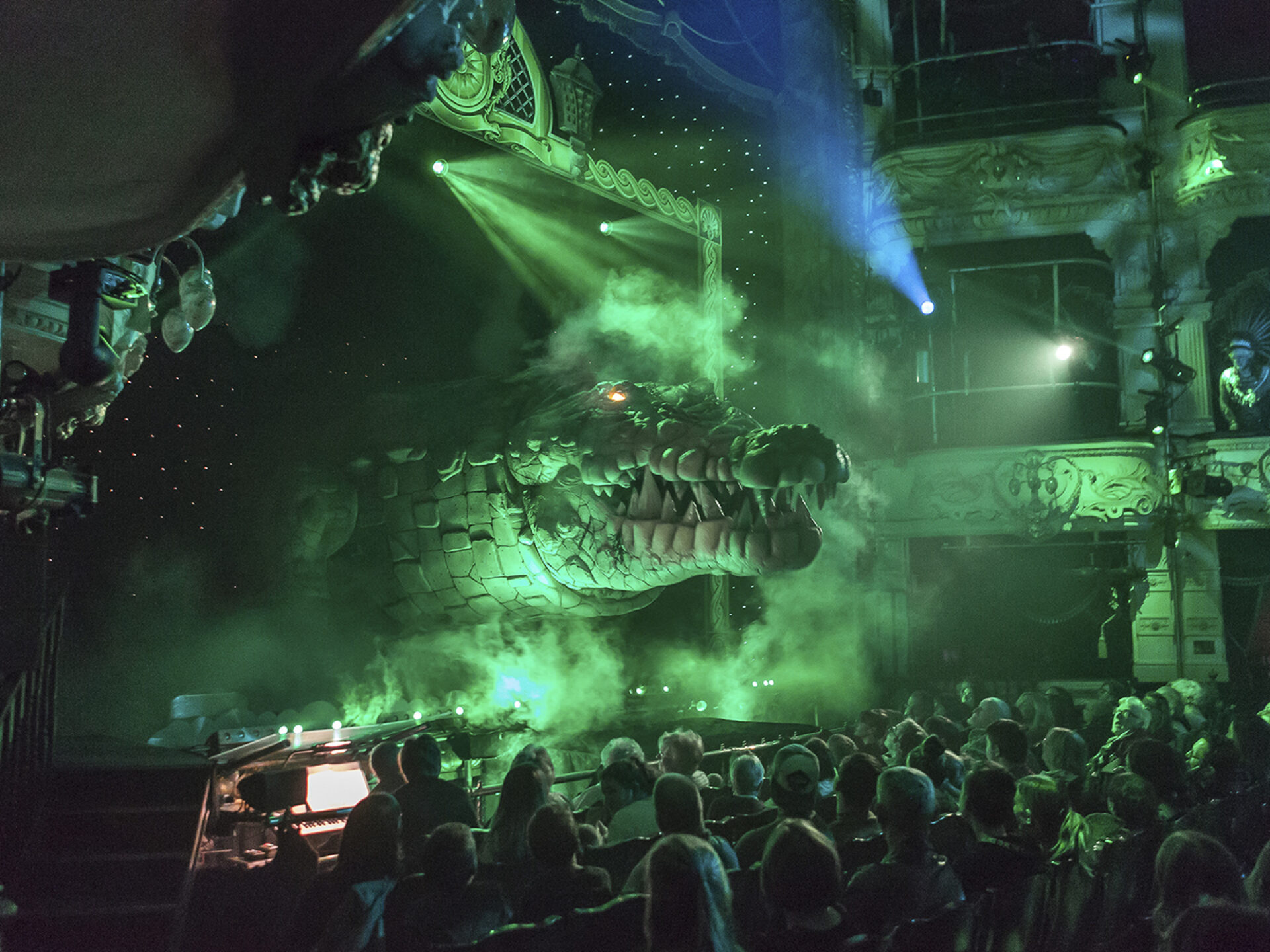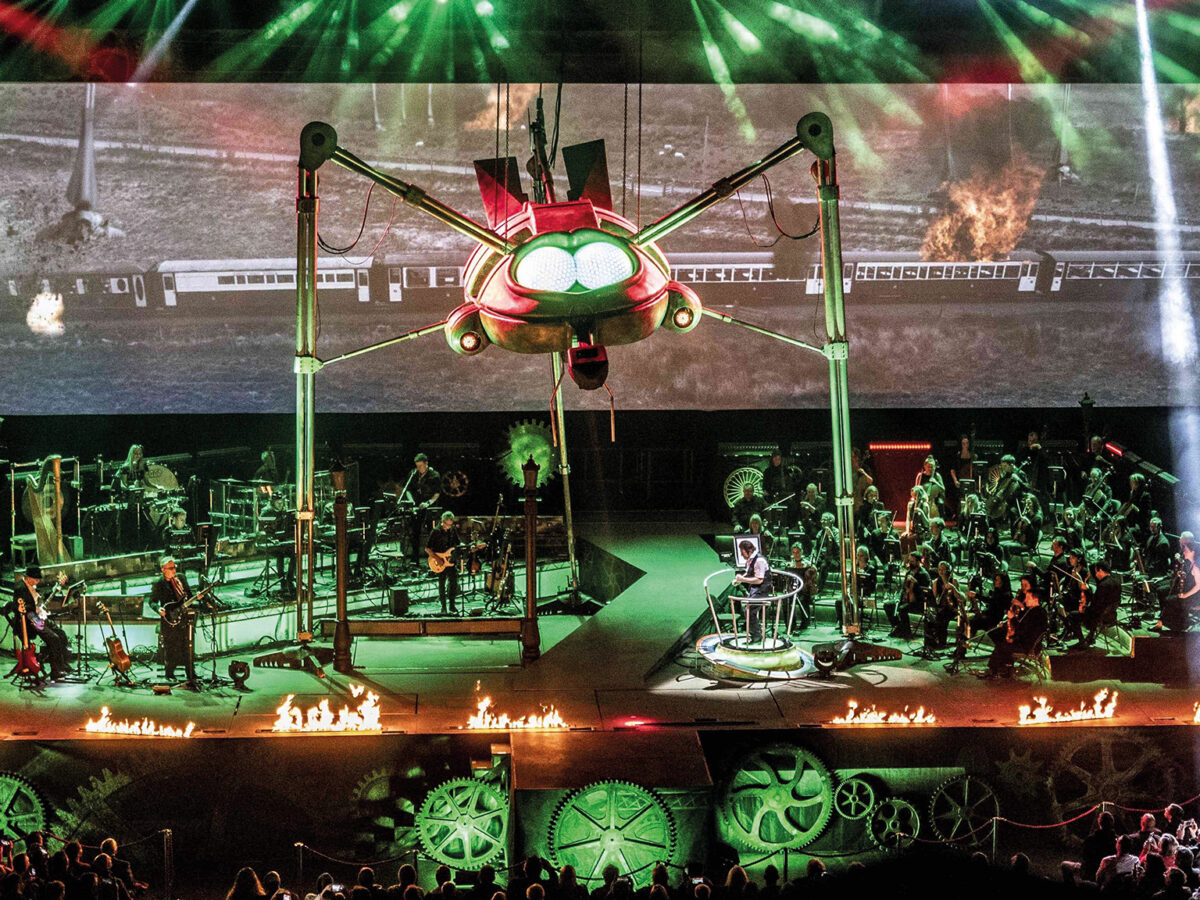May 12, 2021
The Marvellous World of Stage Special Effects

This article was originally published in Populous Magazine, our biannual publication featuring news and trends from the worlds of sport, entertainment, and major public events. Find out more, and sign up to receive a free copy, here.
A monstrous tripod, higher than many houses… a walking engine of glittering metal… a great body of machinery on a tripod stand.” This is how author H.G. Wells described the extra-terrestrial “fighting machines” that invaded Earth in his 1898 sci-fi novel The War Of The Worlds. And that, pretty much, is what appears on stage in the modern-day arena tour of Jeff Wayne’s rock opera adaptation.
“It’s 15 metres tall, it has three enormous pneumatic legs, it weighs four-and-a-half tonnes, and it has a nozzle that shoots flames,” says the musical’s production manager Stephen Nolan. “Then there are five singers, a ten-piece band, 38 string players, a 24-metre by seven-metre projection screen, a holographic screen, and a huge bridge that reaches out 20 metres into the audience. It’s a full-on show.”
In fact, says Nolan, the stage adaptation of Jeff Wayne’s Musical Version of The War Of The Worlds is so big and so technologically complicated that, once it starts, it can’t stop. The entire production – music, lighting, sound and stunning special effects – runs like clockwork to a digital metronome. Everything, from pyrotechnic explosions to computer-generated imagery, is triggered by a computer. The show can’t even pause for applause.
It wasn’t always like this, of course. Spectacular storytelling events have a long history, stretching all the way back to Ancient Rome, when famous naval battles were recreated in flooded amphitheatres, and Ancient Greece, when cranes were used to deliver dramatic endings – the famous deus ex machina. It is in Victorian London, however, that stage shows and special effects first flourished into a form we might recognise today.
Technological developments in lighting, sound and mechanics could be used to achieve extraordinary things in the theatre – from the chariot race in the 1899 production of Ben-Hur to the train crash in the 1909 play The Whip. One designer became so famous for such effects that he earned himself a nickname: Bruce ‘Sensation’ Smith of the Theatre Royal, Drury Lane.
Spectacular theatre enjoyed a renaissance in the 1980s, especially in London’s West End, where Starlight Express featured a roller-skating rink extending into the audience and a swivelling, six-tonne steel bridge, and Miss Saigon used a real helicopter, whisking the musical’s hero from the roof of the American embassy.
Today, the most advanced and extravagant effects, like those in The War Of The Worlds, have migrated from theatres to arenas. Nolan has overseen some of the largest spectacles in the world – from the opening ceremony of the 2015 Rugby World Cup, where a giant rugby ball shed its skin to reveal the Webb Ellis Cup, to the closing ceremony of the 2012 Paralympics, when a fleet of Mad Max-style vehicles lapped the running track. The key, he explains, is never saying no.
“Directors and designers come up with the craziest ideas, and you’ve got to think outside the box to achieve them,” he says. “It helps to have a creative head, as well as a technical head. And a money head, of course.”
"Sometimes, you are not using new technology, you are just using it on a scale that has never been done before."
For Nolan, the cutting edge of special effects is in projection: in 2020, he staged an event in London, using 80 high-power projectors to light up Horse Guards Parade in a dazzling display of colour. “Sometimes, you are not using new technology,” he adds. “You are just using it on a scale that has never been done before.”
The new frontier, he says, involves making the large-scale special effects industry more environmentally friendly. That means using more batteries. It means using more recyclable, sustainably sourced material. And it means re-using effects if possible, rather than leaving them as one-time events for one-off shows.
There is still space for more traditional methods, though. Gary and Paul Hardy-Brown are two brothers who run The Twins FX, a UK-based company supplying the theatre industry with special effects. Christmas is their busiest time of year, when their bespoke designs can be seen in seasonal pantomimes all over Britain.
Their 2,800 square-metre premises, in the Dorset town of Wareham, are stuffed with custom-made creations: a ten-metre-tall Tyrannosaurus Rex; a flying double-decker bus; and even – for the forthcoming Back To The Future musical – a flying DeLorean sports car.
The Hardy-Browns are understandably protective over their professional secrets, but they freely admit some of their more jaw-dropping creations actually rely on relatively simple technology. “Take our flying London bus, for example,” says Gary. “That uses a Jimmy Jib – a counterweighted crane, like an off-kilter see-saw – and that has been around for decades. Obviously we have added hydraulics, and electric motors, and some clever computer stuff. And it takes up to 12 people to operate. But, at its heart, it is actually quite a simple design.”
H.G. Wells would still be mightily impressed.
Stunning theatrical productions have been staged at Populous-designed arenas such as The O2 Arena in London, T-Mobile Arena in Las Vegas, and Coca-Cola Arena in Dubai.
Lorem ipsum dolor sit amet consectetur, adipisicing elit. Non facere corporis et expedita sit nam amet aut necessitatibus at dolore enim quis impedit eius libero, harum tempore laboriosam dolor cumque.
Lorem, ipsum dolor sit amet consectetur adipisicing elit. Illo temporibus vero veritatis eveniet, placeat dolorem sunt at provident tenetur omnis, dicta exercitationem. Expedita quod aspernatur molestias eum? Totam, incidunt quos.
